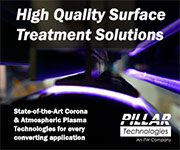Anilox roll advancements raise the quality of flexo
- Published: December 01, 1996, By Boyle, Edward
New anilox roll technologies and materials have paralleled the rise of flexo, and it's no coincidence.
The vast improvement in the quality of flexographic printing over the past ten years has resulted from a number of factors, including ongoing improvements in printing plates, inks, coatings, metering systems, and other critical components of the printing process.
A sometimes overlooked - though no less critical - factor in flexo's ability to produce high quality printed products is the continuing evolution of anilox roll technology. Changes in laser engraving technologies, along with new roll composite materials and print cell structures, have made it easier for converters to achieve superior print results.
"The laser can produce an accurate screen within 0.1 percent because of improvements that laser manufacturers have been making on a continuing basis," says Dave Burgess, VP of manufacturing for Ceramco/Printech, Charlotte, NC. "So, the overall consistency of the laser-produced product is at a higher level than ever before."
Line counts are also getting higher, notes Burgess, resulting in a sharper print image. Screens of 1,000 lines are not uncommon, and some rolls have been produced with up to 1,500 line screens.
Dale Patterson, VP of sales for Harper Corp. of America, Charlotte, NC, says one of the most significant developments in the past 18 months has been the emergence of echotopography, an accurate and repeatable method for measuring cell volume. Using this technology, Harper has been able to reduce ink release variations by half, from [+ or -]8% in volume to [+ or -]4%.
"It guarantees more predictable results and more consistent finished products," according to Patterson.
In addition, leading ink manufacturers have developed inks with enhanced pigmentation, allowing the printer to use less ink to achieve the same desired color depth. Consequently, cell depth is diminished, allowing for reduced dot gain and better contrast.
"The industry in general is looking at, 'How can flexo be more comparable to gravure and litho?'" Patterson suggests. "The advantages those two technologies have had historically is that they control their ink film very well. As we define the delivery and better control the flow of ink, flexo will become more in line with the other two print methods."
Nathan Gilbert, national sales coordinator for Consolidated Engravers, Charlotte, NC, agrees that improvements in computer technology now allow anilox roll manufacturers to certify the cell volume of every laser-engraved roll produced - again improving print consistency.
"Measuring theoretical cell volume of laser-engraved ceramic rolls has been a challenge since they were introduced," says Gilbert. "The solution to the volume-measuring dilemma required the ability to do so in a scientifically competent and demonstrably consistent way."
What has evolved, says Gilbert, is a second generation of computer-controlled, vertically scanning optical profilers that operate on principles of white light interferometry that can measure height differences as little as 0.1 nanometer (or 0.001 micron). Within a field of view as large as 48 sq mm, the system makes in excess of 60,000 depth measurements. From this data the computer creates an ultra-high-resolution contour map of the engraved surface and calculates average cell depths, lpi, screen angle, and cell volume.
"The net benefit is that this technology gives engravers the opportunity for better and tighter control of the laser engraving process," notes Gilbert. "This in turn helps converters control their process, delivering a higher quality product on a more consistent basis to their customers.
Jan Ashfield, customer engineering manager at Praxair Surface Technologies Inc., Charlotte, NC, agrees that the "dramatic" improvement in flexo printing in the last decade is, at least in part, a result of developments in anilox rolls. "Because cell plugging is reduced [with his company's Rainbow rolls], converters will be allowed to continue printing acceptable densities longer, before the rolls require cleaning."
Finally, with the recent emergence of "wide narrow web" presses (with print widths from 22 to 30 in.), anilox roll manufacturers have developed ultra-light rolls that accommodate the wider widths without significantly increasing the weight of the anilox roll itself.
"Weight certainly is an issue in a lot of cases," says Ceramco/Printech's Burgess, "and roll manufacturers have been developing rolls made of lighter material to address safety concerns."













